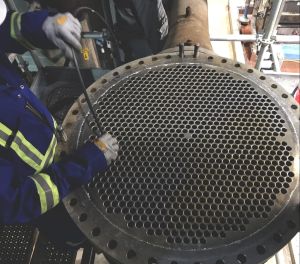
Geotechnical Field Testing Service
Get Price Quote
Cone Penetration Test – 20 Ton Pressuremeter Test – 200 bar Packer Test Permeability Test – Falling / Constant Head Pump Out Test Plate Load Test California Bearing Ratio Test Vane Shear Test. Benkelman Beam Test

Remote Field Eletromangnetic Testing
50,000 Per Day
In the realm of non-destructive testing, remote field testing, or "RFET," is one of numerous electromagnetic testing procedures routinely used. Magnetic flux leakage, conventional eddy current, and alternating current field measurement testing are some of the other electromagnetic inspection methods. Remote field testing is frequently referred to as "Remote Field Electromagnetic Testing" since it is related with eddy current testing. However, there are a few key distinctions between eddy current and remote field testing that will be discussed in this section.Due to the substantial skin effect in ferromagnetic materials, standard eddy current techniques have difficulties inspecting the complete thickness of the tube wall. RFET is primarily used to inspect ferromagnetic tubing.For example, utilising traditional eddy current bobbin probes to inspect a 10 mm thick steel pipe (such as those found in heat exchangers) would necessitate frequencies about 30 Hz to obtain appropriate I.D. to O.D. penetration into the tube wall. Because of the low frequency, the sensitivity of fault detection is quite low. The use of partial saturation eddy current probes, magnetically biassed probes, and pulsed saturation probes can theoretically improve the degree of penetration.These specialised eddy current probes, however, are still limited in their examination capabilities due to the enormous amount of metal present as well as potential permeability fluctuations inside the product.The employment of the remote field-testing approach can substantially reduce the challenges encountered in the testing of ferromagnetic tubes. The advantage of the RFET approach is that it allows for approximately similar detection sensitivities on both the inner and outer surfaces of a ferromagnetic tube. Variations in wall thickness are very sensitive to the approach, although fill-factor changes between the coil and tube are less sensitive. When checking conducting tubular products, RFET can be employed, but it is typically thought to be less sensitive than traditional eddy current procedures.This is a quick and accurate screening tool for determining the condition of ferrous tubing (carbon steel, ferritic stainless steel and Duplex). It can inspect up to 12 mm (1/2 in.) of carbon steel tubing at very low frequencies (100 Hz to 1 kHz) and very high signal gains (> 80 dB). For most examinations, two channels are used: absolute for wall thinning and differential for localised abnormalities. RFT is excellent at measuring wall thinning but not so good for pitting (as compared to ECT). Cleaning the internal bore of tubes with any type of water jet lancing equipment is always recommended to improve inspection findings. Merits of RFET Tube Inspection Suitable for ferromagnetic tubes such as those found in heat exchangers and boilers. Localized corrosion, Pittings. Equally sensitive to internal and external flaws. Can inspect tubes up to 75mm OD with 5mm thickness. Relatively insensitive to probe liftoff or wobble. Typical pull speed between 6” and 12” per second.
Looking for Electromagnetic Field Testing Service Providers

Electromagnetic Field Testing Service
Get Price Quote
Electromagnetic Field Testing Service

Electromagnetic Field Testing
Get Price Quote
Electromagnetic Field Testing, rf planning

Electromagnetic Field Testing
Get Price Quote
Electromagnetic Field Testing, Frequency Response Analyzer, Gm Counter

Electromagnetic Field Testing Services
Get Price Quote
Electromagnetic Field Testing Services, electrical works services